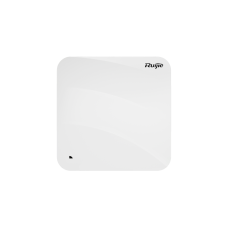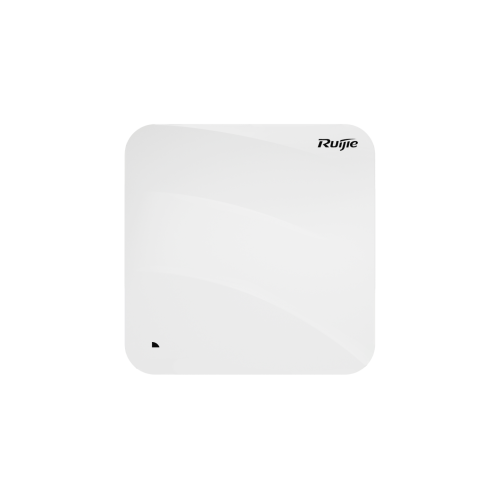RG-SAP845-SP, Wi-Fi 6 Dual-Radio 5.378 Gbps High-Density Enhanced Indoor Access Point Best Price In Dubai, UAE.
Availability:
In Stock
Indoor high-density network scenarios in the higher education, medical industry, government and commerce
Highlight Features
- 5 Gbps combo port for flexible networking
- Upgraded to Wi-Fi 6, high-speed access at 5.378 Gbps
- WIS unified cloud management for easy O&M
Description
Key Specification
Product Overview
The RG-SAP845-SP is a Wi-Fi 6 wireless access point that delivers dual radios, high performance, and enterprise-grade encryption. Its hybrid cloud management mode and high-density access design allow the RG-SAP845-SP to be flexibly deployed in high-quality network scenarios, such as classrooms, dormitories, and large venues in the education industry, production workshops and warehouses in the manufacturing industry, and outpatient clinics and mobile ward rounds in the medical industry.
Product Highlights
Ultra-High Performance
Dual-band design (2.4 GHz + 5 GHz), six spatial streams, 1024-Quadrature Amplitude Modulation (QAM) high-speed access, and up to 5.378 Gbps peak data rate, realizing high-speed wireless access experience Orthogonal Frequency-Division Multiple Access (OFDMA), Multi-User Multiple-Input Multiple-Output (MU-MIMO), and Wi-Fi Multimedia (WMM), increasing the average rate per user in high-density deployment environments RF power adjustment and intelligent channel allocation to solve the problems such as co-channel interference and adjacent channel interference, thereby improving network transmission efficiency and stability
Flexible Networking
Local and cloud management modes, and intelligent wireless network optimization, reducing TCO and maximizing ROI Access through optical and Ethernet cables for flexible networking and high-speed backhaul over 5 Gbps wired links Radio Resource Management (RRM) used to avoid signal interference between APs and interference devices, and to improve user experience IEEE 802.11k/v/r support and roaming stickiness optimization, achieving seamless user roaming Rich IoT features: PoE output, Bluetooth 5.1, and wireless locating
High Security and Reliability
Encryption and authentication technologies including Wi-Fi Protected Access 3 (WPA3), enhanced open security, 802.1X, and Private Pre-shared Key (PPSK), enhancing data security Dynamic Frequency Selection (DFS), optimizing the use of available RF spectrum to prevent radar channel interference Cyclic Delay/Shift Diversity (CDD/CSD), Maximum Ratio Combining (MRC), Space-Time Block Coding (STBC), and Low-Density Parity Check (LDPC), improving the signal quality, signal receiving, and reliability and performance of data transmission Transmit beam-forming (TxBF) expands the signal coverage and enhances the reliability of specific devices, thereby improving the data rate Intelligent identification and monitoring, multicast-to-unicast conversion, and other features, enhancing network security and reliability
Specifications
Hardware Specifications
| Hardware Specifications |
RG-SAP845-SP |
| 802.11n |
Six spatial streams ● Radio 1 – 2.4 GHz: 2x2 MIMO, two spatial streams ● Radio 2 – 5 GHz: 4x4 MIMO, four spatial streams Channels: ● Radio 1 – 2.4 GHz: 20 MHz and 40 MHz ● Radio 2 – 5 GHz: 20 MHz and 40 MHz Combined peak data rate: 900 Mbps ● Radio 1 – 2.4 GHz: 6.5 Mbps to 300 Mbps (MCS0 to MCS15 ) ● Radio 2 – 5 GHz: 6.5 Mbps to 600 Mbps (MCS0 to MCS31) Radio technologies: Orthogonal Frequency-Division Multiplexing (OFDM) Modulation types: BPSK, QPSK, 16-QAM, 64-QAM Packet aggregation: ● Aggregate MAC Protocol Data Unit (A-MPDU) ● Aggregate MAC Service Data Unit (A-MSDU) Dynamic Frequency Selection (DFS) Cyclic Delay/Shift Diversity (CDD/CSD) Maximum Ratio Combining (MRC) Space-Time Block Coding (STBC) Low-Density Parity Check (LDPC) Transmit beam-forming (TxBF) |
| 802.11ac |
Four spatial streams ● Radio 2 – 5 GHz: 4x4 MIMO, four spatial streams Channels: ● Radio 2 – 5 GHz: 20 MHz, 40 MHz, 80 MHz, and 160 MHz Combined peak data rate: 3.467 Gbps ● Radio 2 – 5 GHz: 6.5 Mbps to 3.467 Gbps (MCS0 to MCS9) Radio technologies: Orthogonal Frequency-Division Multiplexing (OFDM) Modulation types: BPSK, QPSK, 16-QAM, 64-QAM, 256-QAM Packet aggregation: ● Aggregate MAC Protocol Data Unit (A-MPDU) ● Aggregate MAC Service Data Unit (A-MSDU) Dynamic Frequency Selection (DFS) Cyclic Delay/Shift Diversity (CDD/CSD) Maximum Ratio Combining (MRC) Space-Time Block Coding (STBC) Low-Density Parity Check (LDPC) Transmit beam-forming (TxBF) |
| 802.11ax |
Six spatial streams ● Radio 1 – 2.4 GHz: 2x2 uplink/downlink MU-MIMO, two spatial streams ● Radio 2 – 5 GHz: 4x4 uplink/downlink MU-MIMO, four spatial streams Channels: ● Radio 1 – 2.4 GHz: 20 MHz and 40 MHz ● Radio 2 – 5 GHz: 20 MHz, 40 MHz, 80 MHz, and 160 MHz Combined peak data rate: 5.378 Gbps: ● Radio 1 – 2.4 GHz: 8.6 Mbps to 0.574 Gbps (MCS0 to MCS11) ● Radio 2 – 5 GHz: 8.6 Mbps to 4.804 Gbps (MCS0 to MCS11) Radio technologies: uplink/downlink Orthogonal Frequency-Division Multiple Access (OFDMA) Modulation types: BPSK, QPSK, 16-QAM, 64-QAM, 256-QAM, 1024-QAM Packet aggregation: ● Aggregate MAC Protocol Data Unit (A-MPDU) ● Aggregate MAC Service Data Unit (A-MSDU) Dynamic Frequency Selection (DFS) Cyclic Delay/Shift Diversity (CDD/CSD) Maximum Ratio Combining (MRC) Space-Time Block Coding (STBC) Low-Density Parity Check (LDPC) Transmit beam-forming (TxBF) WPA3 |
| Antenna |
Wi-Fi ● 2.4 GHz: two built-in omnidirectional antennas, the max. antenna gain is 5.9 dBi. ● 5 GHz: two built-in omnidirectional antennas, the max. antenna gain is 6.2 dBi. Bluetooth ● One integrated vertically polarized omnidirectional antenna, the max. antenna gain is 4.6 dBi. |
| Port |
1 x 100/ 1000/2500/5000Base-T RJ45 Ethernet port with auto-negotiation 1 x 5GE combo SFP port, compatibility with 1GE and 2.5GE, and multiplexing with 1 x 100/1000/2500/5000Base-T RJ45 Ethernet port 1 x 10/100/1000Base-T RJ45 Ethernet port with auto-negotiation 1 x RJ45 console port (serial console port) 1 x USB 3.0 (Type-A connector) 1 x Bluetooth 5.1 |
| Status LED |
1 x multi-color system status LED ● AP power-on status ● Software initialization status and upgrade status ● Uplink service interface status ● Wireless user online status ● CAPWAP tunnel timeout ● Specific AP locating |
| Button |
1 x Reset button ● Press the button for shorter than 2 seconds. Then the device restarts. ● Press the button for longer than 5 seconds. Then the device restores to factory settings. |
| Dimensions (W x D x H) |
Main unit: 230 mm x 230 mm x 51 mm (9.06 in. x 9.06 in. x 2.01 in.) Shipping: 284 mm x 262 mm x 124 mm (11.2 in. x 10.4 in. x 4.9 in.) |
| Weight |
Main unit: 1.0 kg (2.20 lbs) Mounting bracket: 0.1 kg (0.22 lbs) Shipping: 1.25 kg (2.76 lbs) |
| Mounting |
Wall/Ceiling-mount (a mounting bracket is delivered with the main unit) |
| Lock option |
Kensington lock and securing latch |
| Input power supply |
The AP supports the following two power supply modes: ● 54 V DC/1.1 A power input over DC connector: The DC connector accepts 2.1 mm/5.5 mm center-positive circular plug. A DC power supply needs to be purchased independently. ● PoE input over LAN 1: The power source equipment (PSE) complies with IEEE 802.3af/at/bt standard (PoE/PoE+/PoE++). Note: If both DC power and PoE are available, DC power is preferred. |
| Power consumption |
Maximum power consumption: 40 W ● DC power: 40 W, 2.4 GHz radio 2x2, 5 GHz radio 4x4, LAN 2 for PoE supply, and USB port enabled ● 802.3bt (PoE++): 40 W, 2.4 GHz radio 2x2, 5 GHz radio 4x4, LAN 2 for PoE supply, and USB port enabled ● 802.3at (PoE+): 22 W, 2.4 GHz radio 2x2, 5 GHz radio 4x4, LAN 2 and USB port that fail to provide power for external devices (PoE out disabled of LAN 2 and USB port disabled) ● 802.3af (PoE): 12.95 W, 2.4 GHz radio 1x1, 5 GHz radio 1x1, LAN 2 and USB port that fail to provide power for external devices (PoE out disabled of LAN 2 and USB port disabled) ● Idle mode: 10.3 W |
| External power supply |
When powered by 802.3bt (PoE++), the AP can supply power to an external device. ● The USB port can source 1 A/5 W power to an attached device. ● The LAN 2 port can source 48 V/12.95 W power to an IoT unit. |
| Environment |
Storage temperature: –40°C to +70°C (–40°F to +158°F) Storage humidity: 5% RH to 95% RH (non-condensing) Operating temperature: –10°C to +50°C (14°F to 122°F) Operating humidity: 5% RH to 95% RH (non-condensing) At an altitude between 3,000 m (9,842.52 ft.) and 5,000 m (16,404.20 ft.), every time the altitude increases by 166 m (546.81 ft.), the maximum temperature decreases by 1°C (1.8°F). |
| Mean Time Between Failure (MTBF) |
200,000 hours (22 years) at the operating temperature of 25°C (77°F) |
| System memory |
512 MB DRAM, 128 MB flash |
| Transmit power |
2.4 GHz ● Max. transmit power: 27 dBm (500 mW) ● Minimum transmit power: 7 dBm (5.01 mW) 5 GHz ● Max. transmit power: 30 dBm (1000 mW) ● Minimum transmit power: 9 dBm (7.94 mW) Note: ● Adjusting the transmit power by percentage (recommended) and in 1dBm increments. ● The transmit power is limited by local regulatory requirements. |
The following table lists the radio frequency performance of Wi-Fi including different frequency bands, protocols, and date rates. It is country-specific, and Ruijie Networks reserves the right of interpretation.
| Radio Frequency Performance |
RG-SAP845-SP |
||
| Frequency Band and Protocol |
Data Rate |
Max. Transmit Power per Transmit Chain |
Max. Receive Sensitivity per Receive Chain |
| 2.4 GHz, 802.11b |
1 Mbps |
24 dBm |
–96 dBm |
| 2 Mbps |
24 dBm |
–95 dBm |
|
| 5.5 Mbps |
23 dBm |
–93 dBm |
|
| 11 Mbps |
22 dBm |
–89 dBm |
|
| 2.4 GHz, 802.11g |
6 Mbps |
24 dBm |
–91 dBm |
| 24 Mbps |
23 dBm |
–85 dBm |
|
| 36 Mbps |
23 dBm |
–80 dBm |
|
| 54 Mbps |
21 dBm |
–74 dBm |
|
| 2.4 GHz, 802.11n (HT20) |
MCS0 |
24 dBm |
–90 dBm |
| MCS7 |
20 dBm |
–70 dBm |
|
| 2.4 GHz, 802.11n (HT40) |
MCS0 |
24 dBm |
–90 dBm |
| MCS7 |
20 dBm |
–70 dBm |
|
| 2.4 GHz, 802.11ax (HE20) |
MCS0 |
24 dBm |
–90 dBm |
| MCS11 |
16 dBm |
–62 dBm |
|
| 2.4 GHz, 802.11ax (HE40) |
MCS0 |
24 dBm |
–88 dBm |
| MCS11 |
16 dBm |
–60 dBm |
|
| 5 GHz, 802.11a |
6 Mbps |
24 dBm |
–91 dBm |
| 24 Mbps |
23 dBm |
–85 dBm |
|
| 36 Mbps |
23 dBm |
–80 dBm |
|
| 54 Mbps |
21 dBm |
–74 dBm |
|
| 5 GHz, 802.11n (HT20) |
MCS0 |
24 dBm |
–90 dBm |
| MCS7 |
20 dBm |
–68 dBm |
|
| 5 GHz, 802.11n (HT40) |
MCS0 |
24 dBm |
–88 dBm |
| MCS7 |
20 dBm |
–68 dBm |
|
| 5 GHz, 802.11ac (VHT20) |
MCS0 |
24 dBm |
–90 dBm |
| MCS9 |
18 dBm |
–68 dBm |
|
| 5 GHz, 802.11ac (VHT40) |
MCS0 |
24 dBm |
–88 dBm |
| MCS9 |
18 dBm |
–63 dBm |
|
| 5 GHz, 802.11ac (VHT80) |
MCS0 |
24 dBm |
–85 dBm |
| MCS9 |
18 dBm |
–60 dBm |
|
| 5 GHz, 802.11ax (HE20) |
MCS0 |
24 dBm |
–90 dBm |
| MCS11 |
16 dBm |
–60 dBm |
|
| 5 GHz, 802.11ax (HE40) |
MCS0 |
24 dBm |
–86 dBm |
| MCS11 |
16 dBm |
–56 dBm |
|
| 5 GHz, 802.11ax (HE80) |
MCS0 |
23 dBm |
–83 dBm |
| MCS11 |
16 dBm |
–53 dBm |
|
| 5 GHz, 802.11ax (HE160) |
MCS0 |
23 dBm |
–81 dBm |
| MCS11 |
16 dBm |
–51 dBm |
|
Software Specifications
Basic Functions
| Basic Function |
RG-SAP845-SP |
| Applicable software version |
RGOS11.9(6)W3B3 or later |
| WLAN |
|
| Max. number of associated STAs |
1,024 (up to 512 STAs per radio) |
| Max. number of BSSIDs |
32 (up to 16 BSSIDs per radio) |
| Max. number of WLAN IDs |
16 |
| STA management |
SSID hiding Band steering Each SSID can be configured with the authentication mode, encryption mechanism, and VLAN attributes independently. Remote Intelligent Perception Technology (RIPT) Intelligent STA identification technology Intelligent load balancing based on the STA quantity or traffic Rate set settings |
| STA limiting |
SSID-based STA limiting Radio-based STA limiting |
| Bandwidth limiting |
STA/SSID/AP-based rate limiting |
| CAPWAP |
IPv4/IPv6 CAPWAP Layer 2 and Layer 3 topology between an AP and an AC An AP can automatically discover the accessible AC. An AP can be automatically upgraded through the AC. An AP can automatically download the configuration file from the AC. CAPWAP through NAT MTU setting and fragmentation over CAPWAP tunnels Encryption over CAPWAP data channels Encryption over CAPWAP control channels |
| Data forwarding |
Centralized and local forwarding |
| Wireless roaming |
Layer 2 and Layer 3 roaming |
| Wireless locating |
MU and TAG device locating |
| Security and Authentication |
|
| Authentication and encryption |
Remote Authentication Dial-In User Service (RADIUS) PSK and web authentication QR code-based guest authentication, SMS authentication, and MAC address bypass (MAB) authentication Data encryption: WEP (64/128 bits), WPA (TKIP), WPA-PSK, WPA2 (AES), WPA3-Enterprise, WPA3-Individual |
| Data frame filtering |
Allowlist, static blocklist, and dynamic blocklist |
| WIDS |
Wireless Intrusion Detection System(WIDS) User isolation Rogue AP detection and containment |
| ACL |
IP standard ACL, MAC extended ACL, IP extended ACL, and expert-level ACL IPv6 ACL Time range-based ACL ACL based on a Layer 2 interface ACL based on a Layer 3 interface Ingress ACL based on a wireless interface Dynamic ACL assignment based on 802.1X authentication (used with the AC) |
| CPP |
CPU Protect Policy (CPP) |
| NFPP |
Network Foundation Protection Policy (NFPP) |
| Routing and Switching |
|
| MAC |
Static and filtered MAC addresses MAC address table size: 2,048 Max. number of static MAC addresses: 2,048 Max. number of filtered MAC addresses: 2,048 |
| Ethernet |
Jumbo frame length: 1,518 Full-duplex and half-duplex modes of interfaces IEEE802.1p and IEEE802.1Q Optical module information display, alarms about faults, and diagnosis parameter measurement (QSFP+/SFP+/SFP) |
| VLAN |
Interface-based VLAN assignment Max. number of SVIs: 200 Max. number of VLANs: 4,094 VLAN ID range: 1–4,094 |
| ARP |
ARP entry aging, gratuitous ARP learning, and proxy ARP Max. number of ARP entries: 2,048 ARP check |
| IPv4 services |
Static and DHCP-assigned IPv4 addresses Max. number of IPv4 addresses configured on each Layer 3 interface: 200 NAT, FTP ALG and DNS ALG |
| IPv6 services |
IPv6 addressing, Neighbor Discovery (ND), ICMPv6, IPv6 ping IPv6 DHCP client Max. number of IPv6 addresses configured on each Layer 3 interface: 400 |
| IP routing |
IPv4/IPv6 static route Max. number of static IPv4 routes: 1,024 Max. number of static IPv6 routes: 1,000 |
| Multicast |
Multicast-to-unicast conversion |
| VPN |
PPPoE client IPsec VPN |
| Network Management and Monitoring |
|
| Network management |
NTP server and NTP client SNTP client SNMPv1/v2c/v3 Fault detection and alarm Information statistics and logging |
| Network management platform |
Web management (Eweb) |
| User access management |
Console, Telnet, SSH, FTP client, FTP server, and TFTP client |
| Switchover among Fat, Fit, and cloud modes |
When the AP works in Fit mode, it can be switched to Fat mode through an AC. When the AP works in Fat mode, it can be switched to Fit mode through the console port or Telnet mode. When the AP works in cloud mode, it can be managed through Ruijie Cloud. |






Reviews (0)